“Nothing is particularly hard if you divide it into small jobs.” – Henry Ford, Born Jul. 30, 1863.
Everyone knows this. It seems like something Ford would have said as a throwaway, knowing he pioneered assembly line manufacturing.
But don't let this one slide by without considering it.
Every big, ambitious project that you want to accomplish – is really just a sequence of small, easily do-able steps.
Duh. But what are they?
How do you get started?
What do you do first?
What comes next?
And after that?
How do you plan it all out?
What most people miss is that you need to start with the finished outcome, and then work backwards.
If you know what you want to end up with, in full detail, it's a lot easier to break it into components. Then break those chunks into smaller pieces.
And continue until you have a list of tasks that you no longer find intimidating or daunting to do a day at a time, or whatever your schedule allows for.
A product consists of modules. The modules consist of chapters. The chapters consist of sections. Do one section a day.
A sales page consists of a loooong selling argument. The argument consists of specific ordered sections. The sections consist of paragraphs. Do a few paragraphs each night after dinner.
But you have to know what the final outcome really is. In detail. Not a vague “maybe” or a “kinda” or a “what if” scenario.
Nail down your goal. Describe it in writing. Sketch it out. Know EXACTLY what you want to end up with. Once you do, the outline/blueprint/roadmap is a LOT easier to come up with to get you there.
Big projects become little. Long projects get done quickly a bit at a time. And things you once thought were difficult are made easy.
Just like Hank told you.


I often do the opposite. Start with a small action and build it into something grand, see where it takes me. Sometimes it works, but often it doesn't. I've never taken the reverse engineering strategy seriously, until I read this blog post. I think the key is to be consistent, no matter what strategy you use.